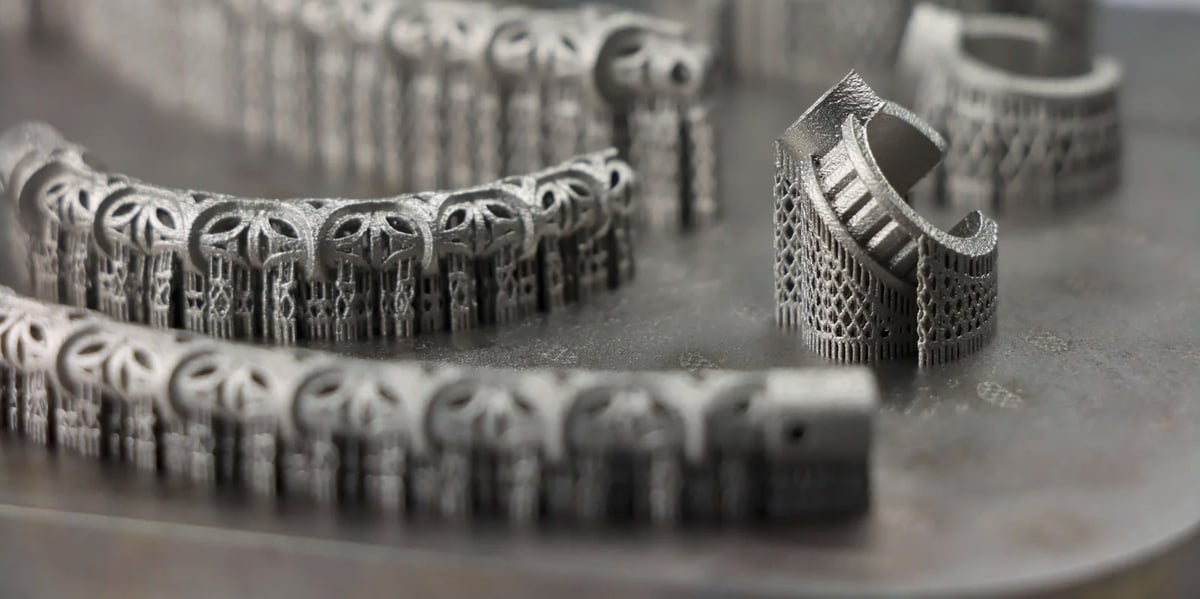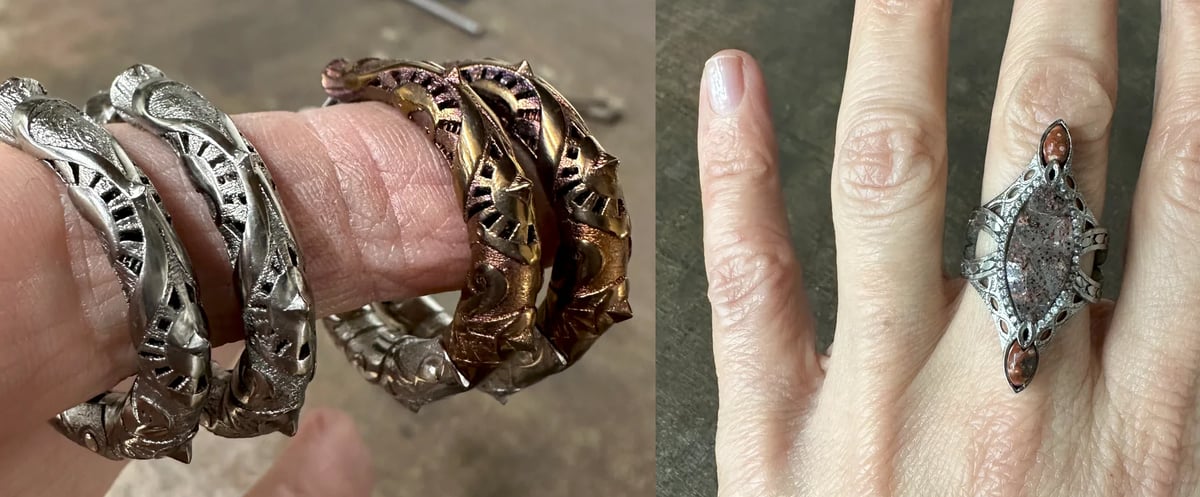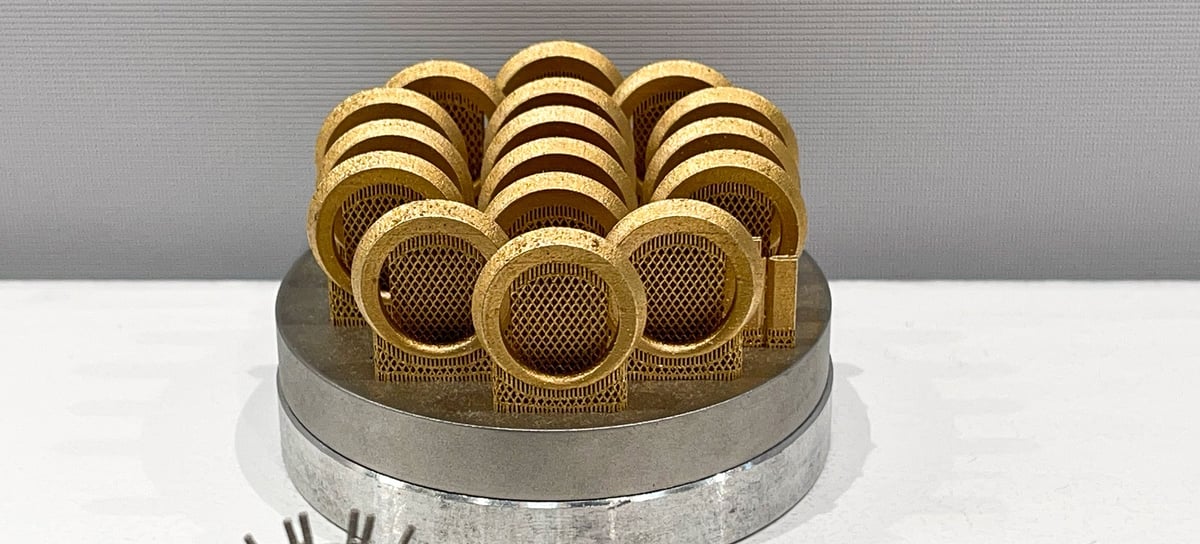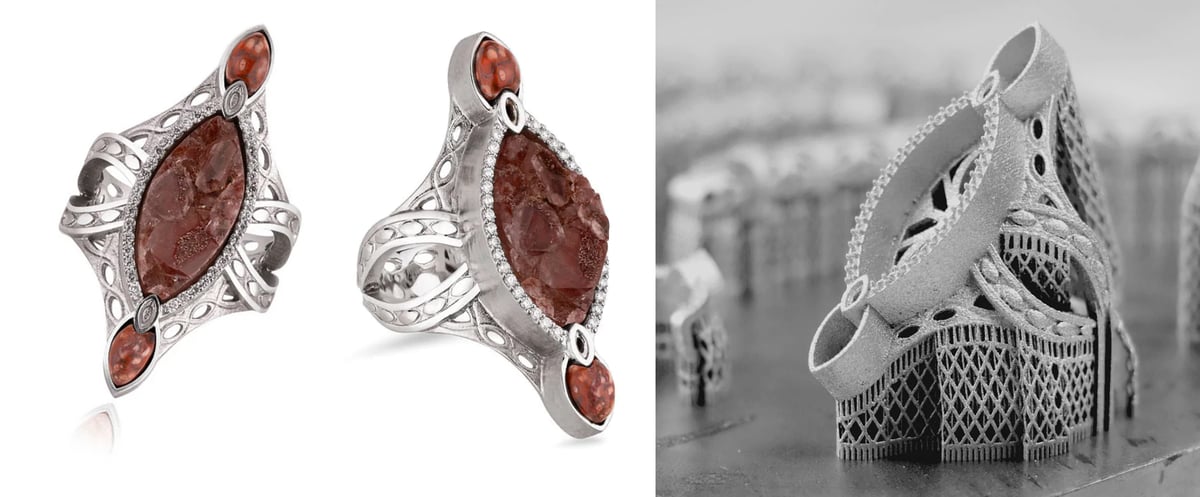Throughout the interview All3DP conducted with Scottish jewelry designer Maeve Gillies, she was wearing the necklace: an intricately Celtic-inspired, lattice-patterned platinum creation set with rare Scottish rocks. It was captivating not only for its beauty but for the feat of 3D printing technology it represents.
In fact, it was created specifically to demonstrate the application of direct 3D printing in platinum to create jewelry that could not be created any other way. Yet, more than a demonstration project, the jewelry is priced, ready to buy, and strives to showcase the pinnacle of what 3D printing can deliver in this industry.

“The 3D printing is actually the focus because my designs are meant to integrate the digital native surface of the 3D printing and showcase that as this moment in technology … and to share the very best of [3D printed] platinum today,” says Gillies.
The necklace is part of a 30-piece 3D printed platinum collection called Tùsaire, which is Scottish Gaelic for “pioneer”. The collection was sponsored by Platinum Guild International to spotlight what’s possible in artistic platinum 3D printing.
Before we dive into the artistic statement that Tùsaire makes about the past and future of jewelry design, the balance of craft and technology, and how elegantly ancient Celtic design mirrors the modern lattice structures of additive manufacturing, let’s look closer at the technology.
Platinum Laser Powder Bed Fusion 3D Printing

Similar to how titanium is used in metal laser powder bed fusion (LPBF) 3D printing of hip implants today, platinum can be made into much lighter-weight larger jewelry pieces than possible with traditional manufacturing.
“The technology catapults platinum into a new place where we’ve never really gone before in making large silhouettes because platinum is traditionally heavier, denser, and very expensive,” says Gillies. Although right now it’s highly desirable because the price is more affordable compared to gold.
Using lattice structures and hollow elements to save on raw materials and make parts lighter is one of the main draws of metal LPBF for manufacturing in general. Gillies built on the current successes of metal 3D printing in other industries for her designs.
“I played in that research-driven, design-thinking space that I’d seen in aerospace, automotive, and medical science,” she says, “then applied it in a decorative way to open doors and take platinum to a brave new place.”

The actual 3D printing of the jewelry was done by Italy-based company ProGold, which uses metal laser powder bed fusion and other technology to develop and produce parts from precious metals for a range of industries.
“[ProGold] has been a key collaborative contributor to making this possible,” says Gillies, who approached the company with Platinum Guild International and her designs. “The team said, ‘we don’t know if we can print it’, and we all said, ‘let’s try.’”
Prototypes began in titanium to figure out how the supports, assembly, articulated elements, and surfaces would work, then printing moved to platinum.
All3DP found ProGold in a quiet booth in the technology section of the Inhorgenta jewelry show where it had samples of its printed jewelry on display. ProGold hadn’t exhibited at Inhorgenta since 2020, but because of the growing demand from large commercial jewelry makers, the company wanted to see if the more high-end, design-focused crowd at this event was also interested, Luca Dal Sasso, sales manager at ProGold, told All3DP.
Dal Sasso says some jewelry manufacturers working with ProGold have designed pieces solely for directly 3D printing because it solves some technical issues. “Laser powder fusion pieces tend to suffer very few common defects, compared to casting, so some of our customers decided that for certain geometries, like certain wall thicknesses, they prefer to switch to direct metal 3D printing.”

Traditional jewelry shapes that can be cast are not the market 3D printing service companies like ProGold are after. But for jewelers with more complex geometries, the technology is often the only efficient way.
According to Dal Sasso, these geometries include large, extended external volumes, flat surfaces, hollow parts, varying wall thickness, or large pieces that, when traditionally cast, require a huge number of feeders and a significant quantity of metal in the casting tree.
“Most manufacturers right now are only using 3D printing and precious metal for efficiency,” says Gillies. Their focus is on whether an application will cost more than casting or less than casting. Manufacturers typically remove the printed surface to make 3D printed pieces look traditionally polished.
The availability of platinum as a powder for LPBF is growing and fueling the popularity in 3D printing. More 3D printers also have become qualified for the material, which can also be printed using binder jet 3D printing. Platinum was customer-qualified by metal maker Legor for the Desktop Metal Production System binder jet 3D printer in 2024 while 3D printer maker Renishaw collaborated closely with Cookson Industrial to adapt its RenAM 500S Flex machine for platinum rhodium production targeting aerospace and electronics industries.
The Common Software for Industries
Gillies’ intricate and sculpted designs were developed in CAD using a combination of Rhino, Autodesk, Maya and ZBrush. “But for me, it all starts with a pencil drawing,” says Gillies. “I always begin by drawing technically accurate manufacturing blueprints of what I want first, before CAD.”
The final designs for pieces, including an articulated chain printed in one piece, were sent to ProGold, which printed the parts and sent them back to Gillies for finishing, stone setting, and assembly.
Jewelry Industry Advances Toward Technology

“I think there’s definitely interest from the industry in how to combine new technologies with traditional bench and manufacturing skills,” says Gillies, who suggests that 3D printing is just another tool in the toolbox.
Walking the aisles of Inhorgenta where Gillies’ line was debuted, it was clear how embedded the traditional craft of jewelry making is. Not only were jewelry-making colleges and universities featuring students hard at work hunched over benches of hand tools, but the “technology” hall barely featured anything that even needed electricity. ProGold was the only company offering direct 3D printing, but we did find Flashforge, which makes an industrial wax 3D printer for making jewelry models used in traditional casting methods.
“As we start to see Al design and technologies influence the market, it is fascinating to see what the technology can do. But seeing creative deployment of these tools by creative minds is the most exciting,” says Gillies. “Technology can help support or enhance crafts people’s time, skills, and expertise. Jewelry represents a powerful and personal maker-to-wearer connection, that can be lost if items are made only by machine. I’ve always strived to combine new manufacturing possibilities with hand finishing and skilled human input.”
The Art & Innovation of Tùsaire

The Tùsaire line, which includes bracelets, rings, pendants, and more, are not pieces that emerge from the 3D printer ready to wear. Intentionally, Gillies designed these to show both the raw surface of the printed part next to sections where that surface is expertly and highly polished.
“Rather than removing the little details of the supports, I’ve contrasted it with highly polished surfaces to look like a surface that’s in contrast with itself, a kind of tension between an ancient Celtic silhouette with this super modern input of technology.”
As well as designing, Gillies teaches Professional Practice to jewelry students at the University of Edinburgh (Edinburgh College of Art) and always seeks to encourage her wider design community to think about what could be done with 3D printing that’s never been done before – to design for the technology specifically.
Although she believes that 3D printing will become native technology to students, Gillies says the bench skills are still the essential foundation of the craft.
“Because this generation is going to be digital-native to 3D printing, there’ll be so many personalizing options together with Al, and suddenly, everyone can be a jewelry designer!” says Gillies. “So I think part of the job of the jeweler may be to find a way to make their unique voice heard, and I’m sure a lot of this will remain through hand skills and personal connections.”
Tùsaire not driven by commerce, rather by creativity. “It’s a love letter to platinum and technology bringing that together with my heritage and trying to do something different,” says Gillies.
That said, the Tùsaire line is available for sale and custom ordering. The initial funding was to get the project started, but based on the data of how well pieces are received and which ones sell, Gilles will be able to develop a more commercially focused and accessible project line.
You May Also Like:
License: The text of "How One Stunning Platinum Necklace Represents the Apex of 3D Printed Jewelry Today" by All3DP Pro is licensed under a Creative Commons Attribution 4.0 International License.


